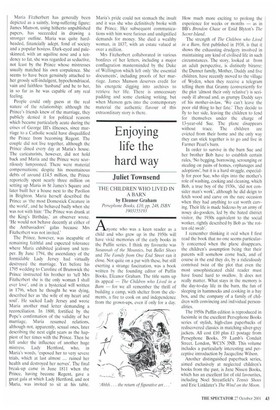Wife in double quotes
Sarah Bradford
MARIA FITZHERBERT: THE SECRET WIFE OF GEORGE IV by James Munson Constable, £20, pp. 372, ISBN 0094782202 On the evening of 15 December 1785 George Augustus Frederick, Prince of Wales, was married by an Anglican clergyman, the Revd Robert Burt, to Mrs Maria Fitzherbert, in the drawing-room of her house in Park Street, Mayfair, in the presence of two witnesses. The heir to the throne was a bachelor, his bride twice widowed, yet their marriage was strictly illegal and in contravention of no less than three Acts of Parliament. Maria Fitzherbert, born Mary Ann Smythe, was a Catholic and among the provisions of the Act of Settlement of 1701 one specifically excluded anyone who married a 'papist' from succeeding to the throne. Further, the Royal Marriage Act of 1772 specified that any marriage contracted by 'descendants of the body' of the late George II without the consent of the monarch was automatically 'void'. Less seriously, the 1753 Marriage Act required vows to be taken in the presence of an Anglican clergyman in an Anglican church, using the Book of Common Prayer, banns having been read out in the couple's respective parish churches beforehand. The only record of the marriage is a hastily scrawled 'certificate' in the Prince's hand in the Royal Archives at Windsor.
Maria Fitzherbert has generally been depicted as a saintly, long-suffering figure; James Munson, using hitherto unpublished papers, has succeeded in drawing a stronger outline. Maria was quite hardheaded, financially adept, fond of society and a popular hostess. Dark-eyed and paleskinned, with an aquiline nose and a tendency to fat, she was regarded as seductive, not least by the Prince whose mistresses usually matched his own corpulence. She seems to have been genuinely attached to her grossly self-indulgent, hypochondriacal, vain and faithless 'husband' and he to her, in so far as he was capable of any real feeling.
People could only guess at the real nature of the relationship; although the Prince's friends knew of the marriage, they publicly denied it for political reasons which became particularly acute during the crises of George III's illnesses, since marriage to a Catholic would have disqualified the Prince from becoming Regent. The couple did not live together, although the Prince dined every day at Maria's house. The caricaturists, however, did not hold back and Maria and the Prince were scurrilously lampooned. There were material compensations; despite his mountainous debts of around £14.5 million, the Prince reportedly spent nearly three million on setting up Maria in St James's Square and later built her a house next to the Pavilion in Brighton. Maria herself described the Prince as 'the most Domestick Creature in the world', and he behaved badly when she was not with him: 'The Prince was drunk at the King's Birthday,' an observer wrote. 'He would not behave decently at either of the Ambassadors' galas because Mrs Fitzherbert was not invited.'
The Prince, however, was incapable of remaining faithful and expected tolerance where Maria exhibited jealousy and temper. By June 1794, the ascendancy of the formidable Lady Jersey had virtually destroyed the marriage. Yet before his 1795 wedding to Caroline of Brunswick the Prince instructed his brother to 'tell Mrs Fitzherbert she is the only woman I shall ever love', and in a hysterical will written in 1796, when he thought he was dying, described her as 'the wife of my heart and soul'. He sacked Lady Jersey and wrote Maria another mad letter demanding a reconciliation. In 1800, fortified by the Pope's confirmation of the validity of her marriage, Maria resumed relations, although not, apparently, sexual ones, later describing the next eight years as the happiest of her times with the Prince. Then he fell under the influence of another huge mistress, Lady Hertford, who, in Maria's words, 'exposed her to very severe trials, which at last almost ... ruined her health and destroyed her nerves'. The final break-up came in June 1811 when the Prince, having become Regent, gave a great gala at which Lady Hertford, and not Maria, was invited to sit at his table. Maria's pride could not stomach the insult and it was she who definitively broke with the Prince. Her subsequent communications with him were furious and undignified demands for money. She died a wealthy woman, in 1837, with an estate valued at over a million.
Mrs Fitzherbert collaborated in various bonfires of her letters, including a major conflagration masterminded by the Duke of Wellington which left only 'the essential documents', including proofs of her marriage. James Munson deserves credit for his energetic digging into archives to retrieve her life. There is unnecessary padding and some clunking writing, but when Munson gets into the contemporary material the authentic flavour of this extraordinary story is there.











































































 Previous page
Previous page